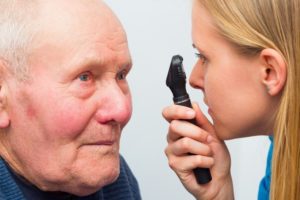Macular Degeneration
 Age-related macular degeneration is the leading cause of vision loss among Americans. In fact, according to the American Macular Degeneration Foundation, AMD has affected more people than cataracts and glaucoma combined. Although the disease cannot be cured, there are treatment options available to prolong eyesight. With years of experience, the board certified ophthalmologists at Visual Health are a trusted choice for patients in the Central and Northern Palm Beach County areas who suffer from AMD.
Age-related macular degeneration is the leading cause of vision loss among Americans. In fact, according to the American Macular Degeneration Foundation, AMD has affected more people than cataracts and glaucoma combined. Although the disease cannot be cured, there are treatment options available to prolong eyesight. With years of experience, the board certified ophthalmologists at Visual Health are a trusted choice for patients in the Central and Northern Palm Beach County areas who suffer from AMD.
What Causes AMD?
The macula is the part of the retina (the tissue located at the back of the eye) that is responsible for clear central vision. It is what allows you to read, recognize faces and perform certain tasks such as sewing. AMD occurs when the arteries that nourish the retina harden, causing the retinal tissues to weaken and die. This in turn leads to vision loss. Because AMD does not affect peripheral vision, it does not cause total blindness. However, the loss in central vision caused by AMD can greatly impact daily life.
Types of Macular Degeneration
There are two types of age-related macular degeneration:
Dry macular degeneration, the most common form of the disease, occurs as a result of aging and thinning of macular tissues. Patients with dry macular degeneration may have symptoms such as loss of retinal pigment and the formation of small, yellowish spots in the retina called drusen. Vision loss with dry macular degeneration can occur at a slower rate than wet macular degeneration.
Wet macular degeneration, a more advanced and severe form of the disease, occurs when new blood vessels develop in the retina and leak blood and fluid. The leakage can permanently damage light-sensitive retinal cells and cause distortions in vision, scar tissue to form and a dark spot in a patient’s central vision to form.
Common Symptoms
- Gradual loss of ability to see objects clearly
- Gradual loss of color vision
- Distorted or blurry vision
- Dark or empty spots in the central vision
The biggest risk factor for AMD is age; individuals age 55 and older have the highest risk of developing the disease. For this reason, older adults are encouraged to have regular eye exams to check to see if they have the eye disease.
Treatment Options for AMD
AMD is diagnosed by a board certified ophthalmologist via an eye exam. One of the most common indications of the disease is drusen appearing under the retina. If the doctor detects symptoms of macular degeneration, there are two valuable tests that will determine the type and severity of the AMD.
 While there is no known cure for dry macular degeneration, there are several ways to manage the condition. Lifestyle changes such as eating an eye-friendly diet, exercising regularly and quitting smoking can reduce your risk of AMD and possibly slow its progression. Wet macular degeneration can be treated with intravitreal injections to reduce or stop the growth of abnormal blood vessels.
While there is no known cure for dry macular degeneration, there are several ways to manage the condition. Lifestyle changes such as eating an eye-friendly diet, exercising regularly and quitting smoking can reduce your risk of AMD and possibly slow its progression. Wet macular degeneration can be treated with intravitreal injections to reduce or stop the growth of abnormal blood vessels.
The best way to determine which treatment option is right for your AMD is by scheduling an appointment with one of the trusted ophthalmologists at Visual Health. To request an appointment with our team, please call our Palm Springs or Jupiter office at 1-800-771-3937.

